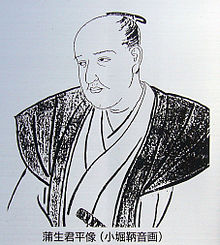Gamō Kumpei
Gamō Kumpei ( Japanese 蒲 生 君平 ; 1768 - July 31, 1813 ) was a Japanese writer, advocate for the establishment of imperial rights. He was one of the "three eccentrics of the Kansei era".
Live and act
Gamō Kumpei was born in Utsunomiya as the son of a merchant. His name was initially Fukuda Hidezane, but when he heard that his family was derived from Gamō Ujisatō, he changed his name to Gamō Kumpei. He went to Edo to study history. During his studies he came together with Fujita Yūkoku ( 藤田 幽谷 ; 1774-1826) and other representatives of the Mito school . This increased his interest in history, and he began to deal with the "true relationship between sovereign and subject" ( 大義名分 Taigi meibun ) from the teaching of Confucius. He soon found that the emperor's authority was not being sufficiently appreciated.
Between 1796 and 1799, Gamō traveled all over Japan to research the imperial tombs. He published the result in 1808 in a book entitled "Notes on the Imperial Tombs" ( 山陵 志 Sanryō-shi ). He also wrote books on the importance of coastal defense and described opportunities for improvement.
Gamō was one of the few writers who dared to represent the imperial cause publicly under the Tokugawa government. He was thus an important forerunner of the restorative movement that eventually led to the Meiji Restoration .
Remarks
- ↑ Drawn by Kobori Tomoto (小 堀 鞆 音; 1864–1931).
- ↑ Am Rinkō-ji ( 臨江 寺 ), Tokyo, Taitō District .
- ↑ The other two eccentrics , the Kansei no sankijin ( 寛 政 の 三 奇人 ), were Hayashi Shihei and Takayama Hikokurō (1747-1793).
literature
- S. Noma (Ed.): Gamō Kumpei . In: Japan. An Illustrated Encyclopedia. Kodansha, 1993, ISBN 4-06-205938-X , p. 716.
- Papinot, Edmond: Gamō Kumpei . In: Historical and Geographical Dictionary of Japan. Reprinted by Tuttle, 1972 edition of 1910 edition. ISBN 0-8048-0996-8 .
Web links
| personal data | |
|---|---|
| SURNAME | Gamō, mate |
| ALTERNATIVE NAMES | 蒲 生 君平 (Japanese) |
| BRIEF DESCRIPTION | Writer and historian |
| DATE OF BIRTH | 1768 |
| PLACE OF BIRTH | Utsunomiya |
| DATE OF DEATH | July 31, 1813 |

